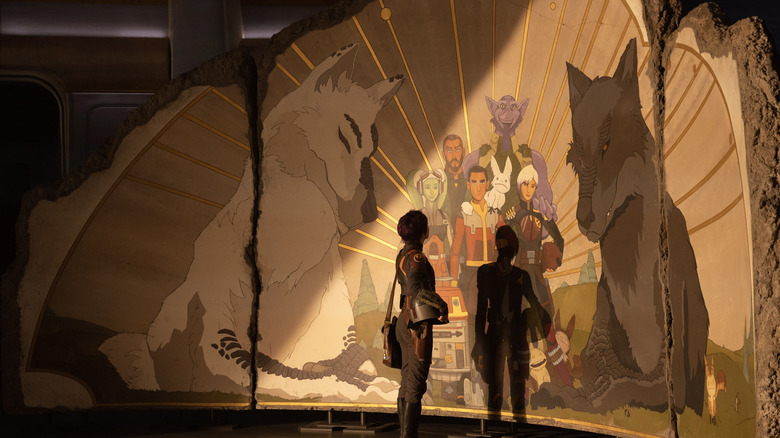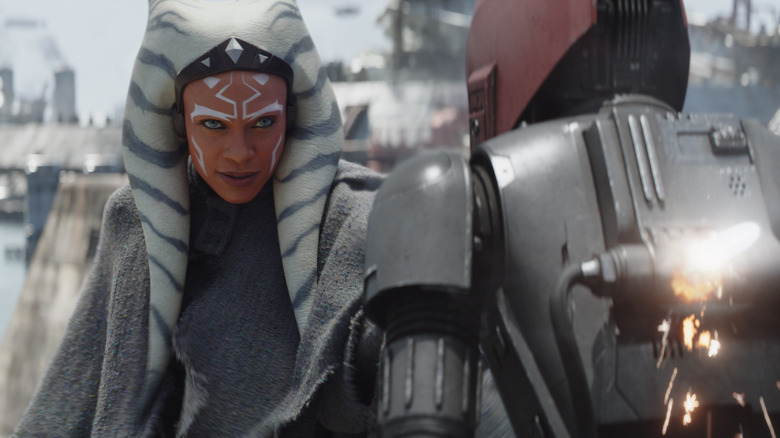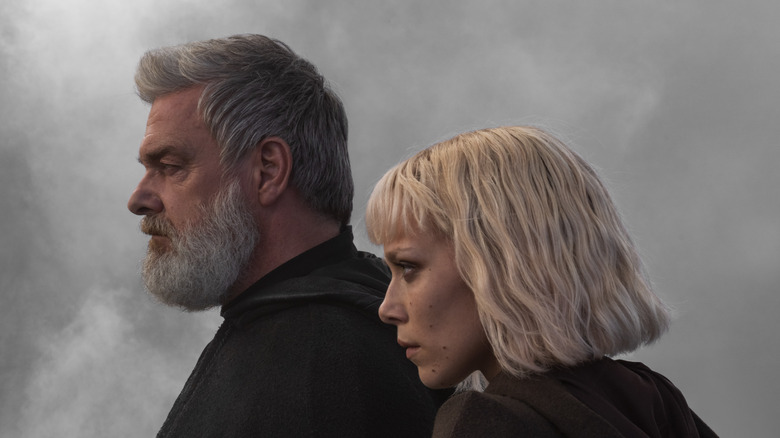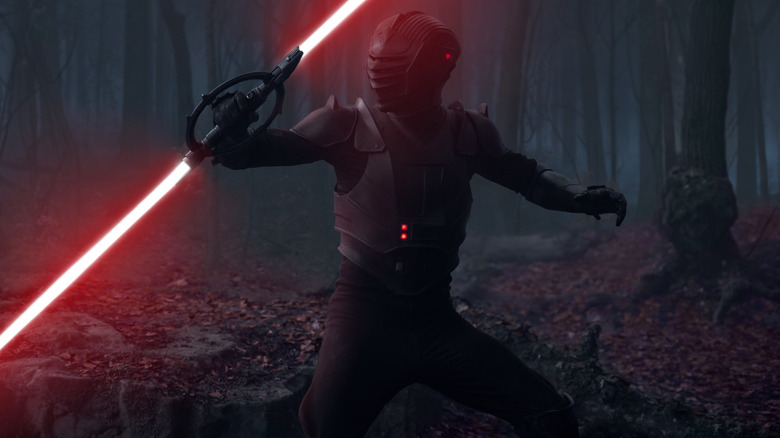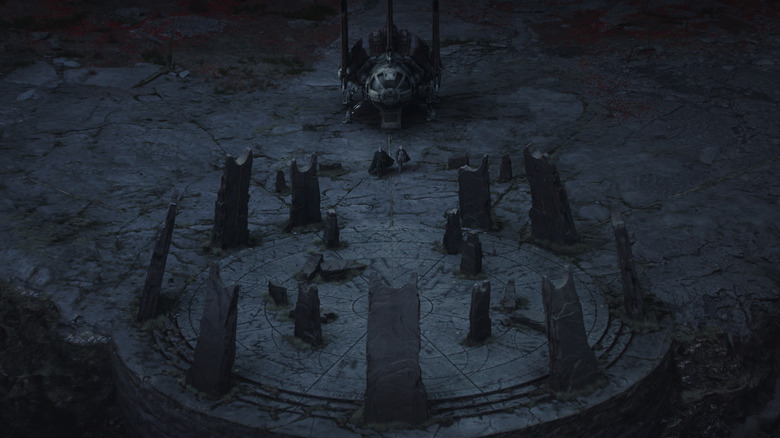Ahsoka Stirs Up Some 'Toil And Trouble' With Its Intriguing New Villains
This article contains spoilers for "Star Wars: Ahsoka" episode 2 — "Toil and Trouble."
The second episode of "Ahsoka" sees Sabine Wren (Natasha Liu Bordizzo) recovering from her dire injuries at the hands of Baylan Skoll's (Ray Stevenson) dark apprentice, Shin Hati (Ivanna Sakhno). Ahsoka (Rosario Dawson) is understandably upset that Sabine put herself in such a reckless position and the two of them continue their bickering, further hinting at the strain their relationship went through during their first attempt at finding Ezra Bridger (Eman Esfandi).
After investigating Sabine's apartment in the old communications tower, Ahsoka finds a leftover HK-series assassin droid and dispatches it. They're able to trace it back to Corellia, where Morgan Elsbeth (Diana Lee Inosanto) once operated shipyards for the Empire. While Sabine recovers, Hera Syndulla (Mary Elizabeth Winstead), Chopper, and Ahsoka head to Corellia to investigate. There, they find Elsbeth's old operation still functioning and loyal to the Empire. The shipyards have been supplying Elsbeth with hyperdrive cores from Super Star Destroyers, allowing her to build a massive hyperspace ring capable of traveling between galaxies — so that she might bring Thrawn (Lars Mikkelsen) back and ring in a new era of the Empire.
Unable to stop them at this point, Hera and Chopper manage to plant a tracking device and hopefully discover their destination for future investigation. As for Ahsoka, she and Sabine come to a new understanding and join forces once again as master and Padawan.
The filmmaking
Steph Green directed this episode, written once again by Dave Filoni, and she's an Oscar and Emmy nominated director. Her talent shines through in all of the filmmaking, making this episode a little more dynamic and action-packed than the "Ahsoka" premiere.
There's one moment in particular that just reeks of one of George Lucas's greatest strengths as a filmmaker, and Green handled it with aplomb. It's when Sabine is hacking into the memory core of the HK-assassin droid. She explains they can push the power levels and extract the information, but if it heats up too much, it'll explode, killing them all. There's a bunch of wires and some displays and readouts, but nothing really tangible to tell the story. Lucas was a master at this sort of story by general implication, shot choice, and movement. Take, for instance, the moment in the podrace where Anakin puts the fire out on his engines in "The Phantom Menace." He pushes some buttons. Things race back and forth from one panel to another. We have no idea what he's doing, but we believe he's doing exactly what the filmmaker intends to tell us. Green does the same thing here, but adding a Hitchcock-style bit of tension with the verbal threat of an imminent explosion. It's really well-wrought stuff.
Another strength is in the action sequences. In this episode, we cross-cut between Ahsoka facing off against a former Inquisitor while Hera and Chopper chase an escaping transport to plant a tracker on it. Lucas was the best at putting together and interconnecting geographically separate action sequences into one emotional story arc and Green has emulated that style in this episode to perfection. It's exciting to see her name more than once on the call sheet of directors we're seeing this season.
Baylan Skoll
The most interesting character in this episode might be Baylan Skoll. When Timothy Zahn created Grand Admiral Thrawn, he set out to craft a villain unlike any we'd seen in "Star Wars." Where the villains of the Empire ruled by fear and anger, Thrawn would be cold and calculating, a limber mind for strategy that inspired utter loyalty in those around him. It would be easy to think that Dave Filoni thought to do the same thing with Baylan Skoll.
When we've seen dark side users and former Jedi in the past, there's been a reckless anger to them. Yet, Skoll seems so calm, collected, and focused. While the Sith relish anger and vanquishing their foes, particularly the Jedi, there's a sad nostalgia to Skoll. In fact, the last exchange he has with Elsbeth at the end of this episode is the one most telling of his complicated character. Elsbeth informs him he needs to deal with Ahsoka and he's overcome with sadness and regret about killing a Jedi. "There are so few left," he tells Elsbeth.
She wonders if he's feeling nostalgic, as Skoll was once a Jedi. He laments that he's simply being honest.
What darkness hides inside Baylan Skoll that he can pity his enemies and wish for better days? What drives him to power? There's a contrast to this resigned sadness and the power he seeks and that makes for a truly interesting, complicated character. Looking at his apprentice, it's obvious he doesn't hate the trappings of the Jedi Order as much as others who had left it. Shin Hati bears a Padawan braid and, according to Huyang, her lightsaber is built in the exact Jedi style he taught, meaning Skoll passed those lessons on.
Of all the characters I want to learn more about, Skoll might be right at the top of the list. Especially with such a soulful final performance (so far) from Ray Stevenson. I can already tell what a great loss he was and I wonder if anyone could possibly fill his shoes if it came to that.
Details to Watch Out For
Corellia plays a major part in this episode, and it's worth noting that this is the first time we've seen Corellia in live-action since 2018's "Solo: A Star Wars Story." This is the planet where Han Solo came from and was trying to escape back to in order to save his friend and love interest, Qi'ra.
One throwaway detail that Baylon Skoll mentions early in the episode is that they have found the "Reflex Point." It's not a term we've heard in "Star Wars" before, but it's an important term in "Robotech," a universe that Dave Filoni has professed to being a huge fan of. In that series, Reflex Point was the codename given to the secret hive of the Invid Queen Regess and the ultimate destination for the heroes. The reference certainly adds another layer to how we're meant to feel about Thrawn if we know it.
It's also worth nothing that when Elsbeth activates the map on Seatos in the Denab sector, green fire accompanies the magic that she conjures. This is a sign that she is definitely descended from the Witches of Dathomir, as that is the visual hallmark of that order's use of the Force.
The other big thing to note is Marrok, who appears to be a former Inquisitor. The Inquisitorius is dead along with the Empire, but he seems to have thrown his lot in with Baylan Skoll, adding another dimension of intrigue and wonder around Skoll's character. Who is he that he could command the loyalty of a Sith Inquisitor?
Alongside Marrok and Shin Hati, Elsbeth has given them access to HK-series assassin droids. These droids really became popular with their introduction in the "Knights of the Old Republic" series and this is their first time showing up in live-action. They've made some brief appearances in the current canon, though just in books.
This episode also marked return of Chopper, everyone's favorite murderous astromech droid. If you're a fan of "Star Wars Rebels," you were just happy to see him.
Toil and Trouble
The title of the episode, "Toil and Trouble," is naturally a reference to "Macbeth," but I think it goes deeper than that. If you recall, the witches in "Macbeth" play a vital part and I think it's a tacit reference to Morgan Elsbeth's growing powers as a Witch of Dathomir. Though whether her powers are growing or are simply being revealed for the first time remains to be seen.
There are visual similarities to Akira Kurosawa's remake of "Macbeth" as well, "Throne of Blood," which was highly influential on George Lucas as he put together Anakin's story for the prequel trilogy. Does this reference and the visual similarities hint at a future where Thrawn might be eventually foiled by his own hubris thanks to the Witches of Dathomir? It feels like a distinct possibility.
This episode is shorter and tighter than the first, advances the story, and raises a number of tantalizing questions. The filmmaking is solid, Steph Green was an excellent choice for this episode, and it looks very much like something that would belong on the big screen rather than a streaming service. For "Star Wars" fans, the questions it raises — particularly about Sabine's ability to train to be a Jedi (I wrote a whole piece about that one particular issue and how it doesn't break or change anything in the canon) — will demand answers sooner than later and that's the hallmark of a good early entry of a show like this. They have us asking a lot of questions without answering even half of them, giving us lots of interesting things to look forward to.
New episodes of "Ahsoka" premiere on Tuesday nights on Disney+ at 6:00pm Pacific, 9:00pm Eastern.
